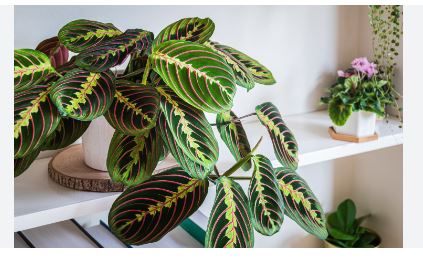
Maranta leuconeura, widely known as the prayer plant due to its daily sunlight-dependent movements, is a species of flowering plant in the family Marantaceae native to the Brazilian tropical forests.
Prayer Plant has oval-shaped leaves, which have unique and vibrant patterns. The leaves often display a mix of greens, with darker green veins or spots, and sometimes with red or purple undersides. This variegation can vary significantly between different cultivars. Plants grow low to the ground, typically reaching up to 12 inches (30 cm) in height, though they can spread wider through their rhizomatous roots.
Maranta leuconeura is known for its nyctinastic movement, where Like a child with hands folded in bedtime prayer, the prayer plant (Maranta leuconeura) closes its colorfully variegated leaves when darkness falls. The broad, elliptical leaves reopen in the morning to reveal fishbone-patterned, white and dark-green centers interlaced with reddish veins against a soft green background.
Grown as a colorful shade-garden perennial in the subtropical areas of U.S. Department of Agriculture plant hardiness zones 10b through 12, prayer plant is an easy-care houseplant elsewhere. They are relatively slow growers and can make suitable for smaller spaces or tabletops.
Cultivation
Light: Bright, indirect light is ideal. Direct sunlight can fade the leaf colors or burn the foliage, while too little light might lead to loss of variegation or reduced growth.
Watering: Keep the soil consistently moist but not waterlogged. Water when the top inch of soil feels dry. Prayer Plants are sensitive to fluoride and other chemicals often found in tap water, so using distilled or rainwater is preferable. They thrive in high humidity environments, ideally above 50%. You can increase humidity by misting the leaves, using a humidifier, or placing the pot on a tray with pebbles and water.
Soil: A well-draining, peat-based potting mix is recommended. Adding perlite or orchid bark can improve drainage while retaining moisture.
Temperature: They prefer temperatures between 60-80°F (16-27°C). Avoid drafts and sudden temperature changes.
Fertilization: Feed every two weeks during the growing season (spring and summer) with a balanced, water-soluble fertilizer diluted to half strength. Reduce feeding in the fall and winter.
Propagation: Prayer Plants can be propagated through division when repotting or via stem cuttings. For the latter, cut a leaf with a bit of stem and plant it in moist soil or water until roots develop.
Repotting: Repot every 1-2 years or when the plant becomes root-bound. This plant prefers to be somewhat snug in its pot, so choose a pot only slightly larger than the current one.
Pests: Watch for common houseplant pests like spider mites, aphids, and mealybugs. High humidity conditions can also lead to fungal issues, so ensure good air circulation.
Special Considerations:
- Foliage Care: Wipe the leaves with a damp cloth to keep them dust-free and enhance their ability to photosynthesize.
- Leaf Curling: If leaves curl or the plant folds its leaves during the day, it might be a sign of stress due to low humidity, overwatering, or underwatering.